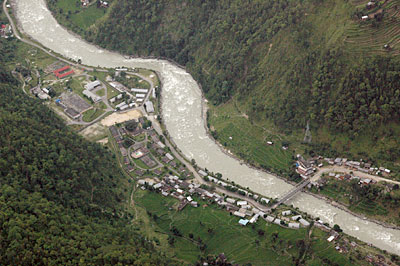 DAMBAR K SHRESTHA |
You don't need to be a Nobel-laureate economist to deduce that Nepal is technically insolvent. Our balance of trade deficit in the last fiscal year (2009-10) amounted to Rs320 billion. It was only Rs216 billion the year before. Our balance of payment deficit during the same period was Rs 2.92 billion. It was favorable by Rs38 billion the previous year.
The business community, renowned economists and the "hydrocracy" argue that the only way out is to export hydropower. Susan Goldmark, the World Bank country director in Nepal, lent credence to this diagnosis by declaring that Nepal's GDP could be comparable to that of Saudi Arabia if we exported hydropower.
Actually, it is because Nepal for the past two decades concentrated on projects to export hydropower that we are suffering an energy crisis in both electricity and petroleum products. This situation will get worse unless policymakers refocus and realign the country's energy policy.
Nepal's famed potential of 43,000 MW will generate 188 billion kilowatt-hours (units) of electricity if implemented at 50 per cent average plant factor (which ranges from 20-25 per cent for storage projects to 65-70 per cent for run-of-the-river projects). Exporting at 5�/unit (the rate for peak-in West Seti power that India's PTC agreed to) will generate a revenue of $9.4 billion/year, which amounts to only 3 per cent of Saudi Arabia's GDP in 2006.
Many people have also jumped to the conclusion that exporting power will mitigate Nepal's balance of payment deficit. Not true. Even at a low ballpark cost of $1,000 per kilowatt, implementing 43,000 MW will entail an investment of $43 billion which is beyond Nepal's means. The only alternative is to build with foreign direct investment which will also mean that almost all of the hydro-dollars will get repatriated from Nepal as return on investment and debt service, except for royalties to be paid to the government (income from hydropower neither attracts income tax nor is electricity VAT-able) and a small amount spent on local salaries, a substantial portion of which will go for expat wages. The operation and maintenance cost of such projects and corporate overheads will also not stay in Nepal. Only three percent of the dollars we generate from exporting hydropower will actually stay in Nepal, and will help ease our balance of payment deficit to that extent only.
A country's economy benefits from value addition due to increased exports. This manifests in favourable balance of trade, triggered by augmented employment as a cascade impact of industrialisation necessary for incremental production for export. But in the case of hydro-dollars, value addition will not be commensurate to export, it will be limited by the quantum of percolation into Nepal's economy. Ninety-seven percent of hydro-dollars flowing out of the economy will not meaningfully add value, and will neither increase industrialisation nor generate employment.
Nepal's priority should be to use hydropower for value addition and to wean ourselves from our dependence on imported petroleum (which aggravates the balance of trade and payment deficit) by electrifying the public transportation system (also generating carbon offset benefits) thereby ensuring overall energy security. We must also aim to supplant the use of animal and agricultural residue and firewood, which cause indoor pollution that reduces the productive life of, mainly, women.
This doesn't mean that hydropower shouldn't be exported at all. But it would be foolish for Nepal to have projects built to export at around Rs2 per unit, and import at over Rs10 just to mitigate load-shedding and perpetuate our dependency on petroleum. The country's best interest will be served by buying electricity at the lowest rate from developers capable of building projects cost effectively, and use the electricity to meet our own demand to supplant non-renewable and unclean sources. Nepal, not the project developers, should export the remaining electricity at premium price, because demand and price in India is highest when Nepal "spills" energy during the monsoon.
Read also:
"Power can be our most valuable export"
From basket case to bread basket, KUNDA DIXIT in DHAKA
See also:
No light at the end of the tunnel, DEWAN RAI and RUBEENA MAHATO



